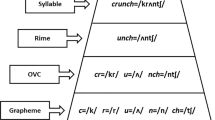Abstract
A number of previous studies found that the consistency of sound-to-spelling mappings (feedback consistency) affects spoken word recognition. In auditory lexical decision experiments, words that can only be spelled one way are recognized faster than words with multiple potential spellings. Previous studies demonstrated this by manipulating feedback consistency of rhymes. The present lexical decision study, done in English, manipulated the spelling of individual vowels within consistent rhymes. Participants recognized words with consistent rhymes where the vowel has the most typical spelling (e.g., lobe) faster than words with consistent rhymes where the vowel has a less typical spelling (e.g., loaf). The present study extends previous literature by showing that auditory word recognition is affected by orthographic regularities at different grain sizes, just like written word recognition and spelling. The theoretical and methodological implications for future research in spoken word recognition are discussed.
Similar content being viewed by others
Notes
The rhyme /es/ in face can be spelled as \(\langle \text{ ace }\rangle \text{ or } \langle \text{ ase }\rangle \). However, these two variants differ only in the coda spelling, not in the vowel spelling, which, just like in all other stimuli, is consistent across all words ending in /es/. The consistency of coda spelling was controlled for in the study.
The by-subject \(t\) test does not allow controlling for variables that co-vary with item group. The by-item analysis, on the other hand, has been criticized for violating the assumption of independency of observations in two compared samples. Indeed, because responses to two groups of items come from the same subjects, the two sets of observations compared in the by-item t-test are not independent. See also Baayen (2004) and Baayen et al. (2002) for a more in-depth discussion.
References
Baayen, R. H. (2004). Statistics in psycholinguistics: A critique of some current gold standards. In G. Libben & K. Nault (Eds.), Mental lexical working papers I (pp. 1–45). Edmonton.
Baayen, H. R., Tweedie, F. J., & Schreuder, R. (2002). The subjects as a simple random effect fallacy: Subject variability and morphological family effects in the mental lexicon. Brain and Language, 81, 55–65.
Balota, D. A., Cortese, M. J., Hutchison, K. A., Neely, J. H., Nelson, D., Simpson, G. B., et al. (2002). The English Lexicon Project: A web-based repository of descriptive and behavioral measures for 40,481 English words and nonwords. http://elexicon.wustl.edu, Washington University.
Davies, M. (2008). The corpus of contemporary American English (COCA): 400+ million words, 1990-present. Available online at http://www.americancorpus.org.
Dich, N. (2011). Individual differences in the size of orthographic effect in spoken word recognition: The role of listeners’ orthographic skills. Applied Psycholinguistics, 32, 169–186.
Dich, N. (2010). Sensitivity to phonological context in L2 spelling: Evidence from Russian ESL speakers. Written Language and Literacy, 13, 99–117.
Frost, R., & Ziegler, J. C. (2007). Speech and spelling interaction: The interdependence of visual and auditory word recognition. In M. G. Gaskell (Ed.), The Oxford handbook of psycholinguistics (pp. 107–118). Oxford, New York: Oxford University Press.
Grainger, J., & Ziegler, J. C. (2007). Cross-code consistency effects in visual word recognition. In E. L. Grigorenko & A. Naples (Eds.), Single-word reading: Biological and behavioral perspectives (pp. 129–157). Mahwah, NJ: Lawrence Erlbaum Associates.
Kessler, B., & Treiman, R. (2001). Relationships between sounds and letters in English monosyllables. Journal of Memory and Language, 44, 592–617.
Nusbaum, H. C., Pisoni, D. B., & Davis, C. K. (1984). Sizing up the Hoosier mental lexicon: Measuring the familiarity of 20,000 words (Research on Speech Perception Progress Report No. 10). Bloomington: Indiana University, Psychology Department, Speech Research Laboratory.
Perre, L., & Ziegler, J. C. (2008). On-line activation of orthography in spoken word recognition. Brain Research, 1188, 123–138.
Perry, C., & Ziegler, J. C. (2004). Beyond the two-strategy model of skilled spelling: Effects of consistency, grain size, and orthographic redundancy. The Quarterly Journal of Experimental Psychology Section A, 57, 325–356.
Pinheiro, J. C., & Bates, D. M. (2000). Mixed-effects models in S and S-PLUS (Statistics and Computing). New York: Springer.
Salverda, A. P., & Tanenhaus, M. K. (2010). Tracking the time course of orthographic information in spoken-word recognition. Journal of Experimental Psychology: Learning, Memory, and Cognition, 36, 1108–1117.
Treiman, R., Kessler, B., & Bick, S. (2002). Context sensitivity in the spelling of English vowels. Journal of Memory and Language, 47, 448–468.
Ventura, P., Morais, J., & Kolinsky, R. (2007). The development of the orthographic consistency effect in speech recognition: From sublexical to lexical involvement. Cognition, 105, 547–576.
Ziegler, J. C., & Ferrand, L. (1998). Orthography shapes the perception of speech: The consistency effect in auditory word recognition. Psychonomic Bulletin & Review, 5, 683–689.
Ziegler, J. C., & Goswami, U. (2005). Reading acquisition, developmental dyslexia, and skilled reading across languages: A psycholinguistic grain size theory. Psychological Bulletin, 131, 3–29.
Ziegler, J. C., Petrova, A., & Ferrand, L. (2008). Feedback consistency effects in visual and auditory word recognition: Where do we stand after more than a decade? Journal of Experimental Psychology: Learning, Memory & Cognition, 34, 643–661.
Ziegler, J. C., Stone, G. O., & Jacobs, A. M. (1997). What is the pronunciation for -ough and the spelling for /u/? A database for computing feedforward and feedback consistency in English. Behavior Research Methods, Instruments & Computers, 29, 600–618.
Author information
Authors and Affiliations
Corresponding author
Appendix: Stimuli Used in the Study
Appendix: Stimuli Used in the Study
Words
Typical | Atypical |
|---|---|
Bathe | Beige |
Book | Bush |
Coke | Coach |
Depth | Death |
Face | Faith |
Fish | Fierce |
Hedge | Health |
Lisp | Lymph |
Lobe | Loaf |
Munch | Month |
Nib | Nymph |
Pinch | Pierce |
Robe | Roach |
Sketch | Scarce |
Wedge | Wealth |
Wood | Wolf |
Nonwords

Rights and permissions
About this article
Cite this article
Dich, N. Orthographic Consistency Affects Spoken Word Recognition at Different Grain-Sizes. J Psycholinguist Res 43, 141–148 (2014). https://doi.org/10.1007/s10936-013-9247-5
Published:
Issue Date:
DOI: https://doi.org/10.1007/s10936-013-9247-5




